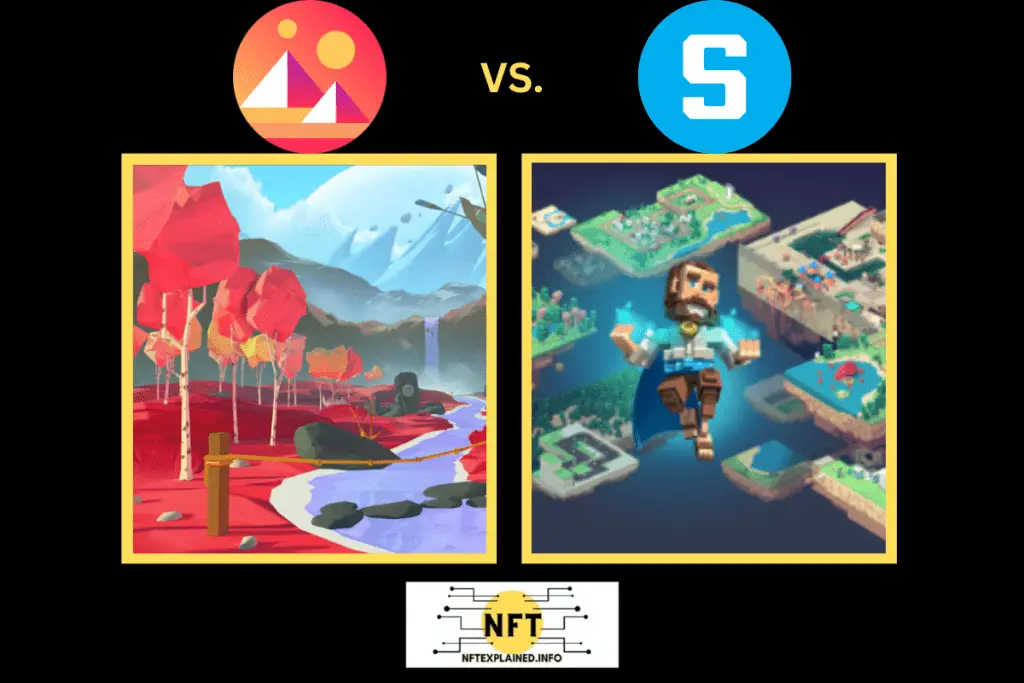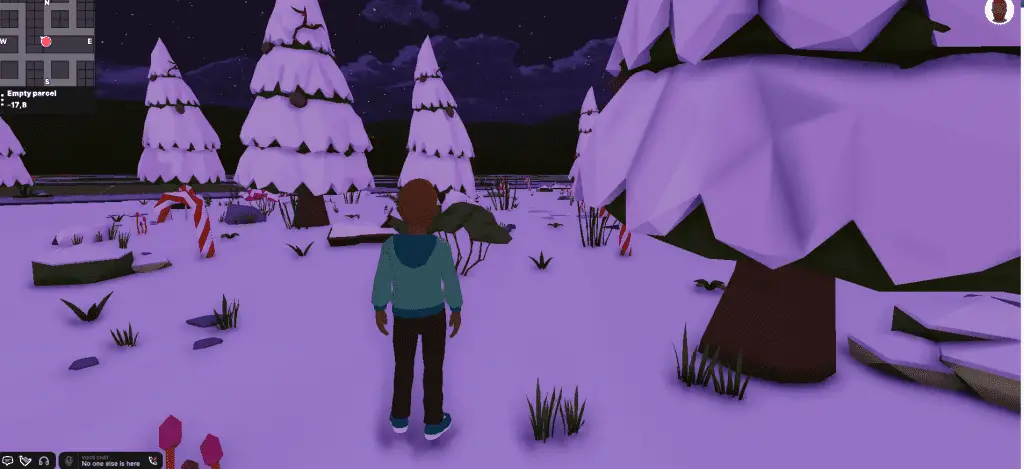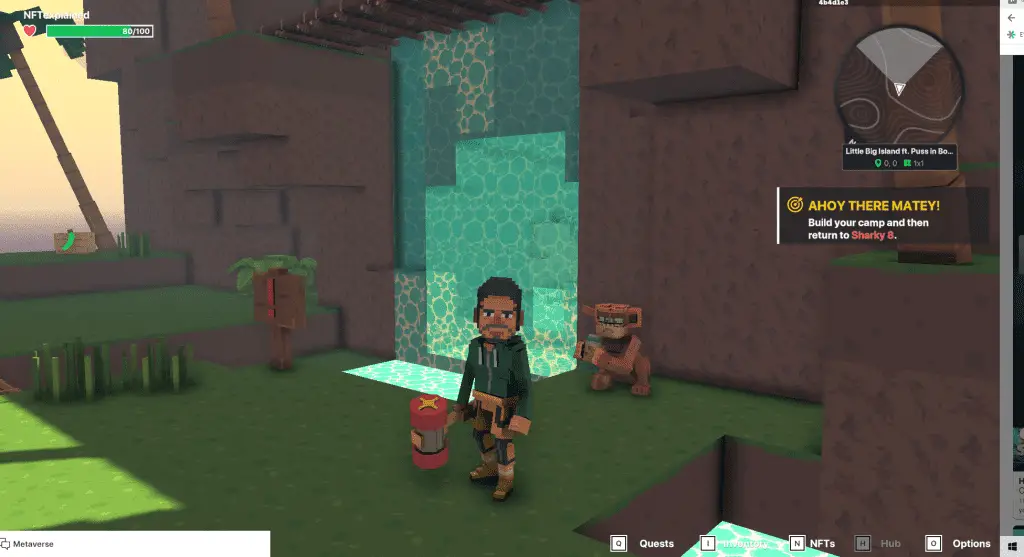
Decentraland and The Sandbox are two metaverse related games that rely heavily on blockchain technology and have an infrastructure that is comparable to very few games; many would say these two metaverses are in their own category of gaming.
NFT have allowed users to own assets within games and Decentraland and The Sandbox have acted as a gateway to show the many possibilities that this new technology has.
Our team has covered both of these metaverses and if you would like to further examine either one, we will link our Decentraland article and our The Sandbox article.
Let’s dive in and then examine the many aspects that allow you to analyze a blockchain-based game.
As a general statement it is impossible to say which metaverse is better because they are continuously being developed and they both have different strengths/weaknesses. Decentraland boasts its more decentralized aspects while many have said that The Sandbox is more ‘gaming’ focused.
Long-term it’s impossible to say which metaverse will be the clear winner as both games are still in their infancy and only developments – that will come with time – will allow us to clearly state which metaverse is better. That being said, let’s examine the strengths and weaknesses of both.
In this chart we will look at an array of different features that both games possess and use an ‘x’ to indicate which metaverse we think wins (for the given section). Please note that sections where both metaverses received an ‘x’ indicates a tie. Following the chart we will explain our reasoning.
| Decentraland | The Sandbox | |
| ERC-20 Tokens | x | x |
| Decentralization | x | |
| Graphics | x | |
| Controls | x | x |
| Land | x | |
| Marketplace Fees’ | x | |
| Blockchain | x | x |
| Roadmap | x | |
| Interactions | x | |
| Events | x | |
| Building Capabilities | x | x |
| Monetization | x | |
| VR Capabilities | x | x |
| Overall Fun | x |
While these metrics our team looked at clearly aren’t equal and many of the metrics had two ‘x’ as there was a clear tie, let’s examine the totals before explaining our reasoning. Decentraland had 9 and The Sandbox had 10 – indicating just how challenging it is to say which one is better.
We decided to give Decentraland and The Sanbox the same result with regards to the ERC-20 tokens or the cryptocurrencies that the games use. Decentraland’s utility token $MANA and The Sandbox utility token $SAND both serve very similar functions.
Both cryptocurrencies are used in-game to facilitate transactions (i.e. minting of NFTs) and therefore the in-game economy. Additionally, both tokens have some amount of voting power towards the direction the project goes in as they are governance tokens.
Amidst what many would consider to be a bear market, the current market cap of both tokens are approximately the same; however, their fully diluted market cap differ. $MANA currently has a fully diluted market cap of approximately US $880 million while $SAND currently has a fully diluted market cap of US $1.6 billion.
The core difference between the two brings us to the next section – decentralization. The Sandbox is less decentralized in comparison to Decentraland (hence the name ‘decentra’) as Decentraland is run completely by a Decentralized Autonomous Organization (DAO).
If you would like to learn more about Decentraland’s DAO including the Aragon which it is built atop of, click here.
All policies are created and voted on by the Decentraland community or users themselves. Additionally, the private key that controls the $MANA smart contract has been thrown away; this means the founders would never be able to run away (rug pull) funds and are unable to mint more tokens.
On the other hand The Sandbox token doesn’t allow for voting – at present; however, the founders have indicated that they want to implement this in the future. Again, this is why our team stated that the infancy of the two make it challenging to declare a clear winner.
With regards to graphics, we gave The Sandbox the upper hand however it is no doubt that the two are very similar and there was disputes among our team. We came to the conclusion that The Sandbox renders faster and has less glitches – therefore making it have better graphics.
That being said, the two both have block like textures that do not make for very realistic gameplay. We will attach an image of both games below so you can see for yourself.


From a purely image capturing standpoint, the two are very similar and some may even argue that Decentraland has better graphics but again, our team is basing our decision on the glitches and the amount of time it takes for areas to render.
Our team will note that both screenshots were taken on the same computer.
Moving on to controls, both metaverses are tied as the controls are almost exactly the same; controls are typical to most desktop computer games. W, A, S, D are used to move around with the space bar being your control to jump.
For land, our team decided to go with The Sandbox, simply, because more plots of land are available. Decentraland has 90,601 plots of digital real estate in the form of NFTs while The Sandbox has 166,464 NFTs available.
For marketplace fees’, Decentraland takes the win because of the lower percentage taken. Decentraland takes 2.5% of every transaction through burning $MANA; however, this is subject to change and has been changed numerous times through votes on the Agora (which is run by the Decentraland DOA).
The Sandbox has higher marketplace fees’ – double to be exact (i.e. 5%) – and these fees are given to the Foundation Pool (which is used to incentivize players and those building within the game).
Moving on to blockchain, there is no dispute for a tie as both games were originally created atop the Ethereum blockchain; however, both have enabled transactions to occur on the Polygon blockchain because of the low fees and energy consumed.
Regarding roadmaps, The Sandbox is the clear cut winner because The Sandbox is the currently the only one with a clear cut path set in stone; at present this includes getting the metaverse related game onto smartphones amongst other goals.
Since Decentraland is more decentralized, proposals are created by the community and no clear cut goals are set far ahead; that is the core reason why our team thought The Sandbox deserved the victory for the better roadmap.
For interactions, our team was referring to the ability to communicate with other users. This aspect favors Decentraland because the ability to communicate with people in the area, people directly, and through voice is possible.
For The Sandbox, users only have the option to type in order to communicate with other users in a chat known as the “metaverse”; additionally, no option to communicate with voice is currently present. Our team also found that people in Decentraland are more likely to read the chat and communicate in comparison to The Sandbox.
For events, our team was referring to in-game occasions that are set up; we looked at how good these events are and how frequently they happen. While Decentraland has an impressive list of events to choose from including party, NFT, Music, Education, and more – our team went with The Sandbox.
We chose The Sandbox because the events within The Sandbox are created more professionally and are created through partnerships done with the founding team. On the other hand, many of the events on Decentraland are far less professional and are simply created by users (although some are quite impressive).
While there aren’t nearly as many events in The Sandbox in comparison to Decentraland, The Sandbox events are of higher quality and include many quest that make them fun (even for users who don’t own any NFTs or $SAND).
Another aspect our team looked at was building capabilities or the east at which players can create, especially those without coding experience. Building capabilities was a tie for both games and both metaverses have easy to use platforms that require no coding knowledge. These platforms are called Builder for Decentraland and VoxEdit for The Sandbox.
For Decentraland, the SDK can be integrated and is a viable option for those that enjoy coding.
Both metaverses allow you to create without publishing your creations to the metaverse; this is an option many will use as lots of players don’t own the land or the assets being used atop that land (which therefore making them unable to publish their creation to the blockchain). This option is known as the scene pool in Decentraland and the draft gallery in The Sandbox.
For monetization, our team found it challenging to decide however we ending up choosing Decentraland simply because renting our land can be done in-house, meaning the service is provided by Decentraland and is facilitated by smart contracts.
The Sandbox had many of the same features – including the ability to monetize 3D assets (e.g. clothes) – however being able to rent out land currently isn’t possible (in house) and has to be done through a third party. Our team covered a viable option to renting out land in our guide to earning passive income with NFTs, which can be found here.
At present, both metaverses don’t have VR capabilities which is why our team decided this would be a tie. If you are interested in learning about some of the existing, top metaverse related devices – click here.
For overall fun, our team went with The Sandbox, simple because the game had more features to it. For example, with the events that are already built out and being hosted (e.g. Care Bears), there are many quest the user can complete.
While there are many awesome location and events within Decentraland, there is still lots of locations that aren’t built out which makes the metaverse appear more lonely. Additionally, The Sandbox has many bots that look similar to the avatars you can create, making it feel like there is more people. Decentraland does have many bots you can talk to however lots of them take the form of robots and other creatures.
The Sandbox also doesn’t allow you to explore land that has not been developed whereas Decentraland does, which again can put the user in a location with little to see and do.
To conclude our teams thought on the two metaverses, we would like to go back to our original sentiment where we stated that its impossible to definitively say which metaverse is better – especially given that both are in their infancy.
Let us know your thoughts on which metaverse you like more by connecting with our team on Instagram, Twitter & TikTok! As well as subscribe to our YouTube!
Additionally, please consider supporting our team’s content creation through doing business with our partners: Buy a Ledger hardware wallet. Trade stocks & crypto on Webull – get 2 free stocks. U.S. users can get a crypto trading discount on Binance!
